Keywords
Invasive, Medicinal value, Asteraceae, Genera
Introduction
Invasive plant means the plant which is not native in an area or a country. They are exotic and introduced via various biotic or non-biotic agents. These exotic plants may be weeds of crop fields, ornamental plants or economic plants. Mainly through the food grain transportation all over world the plant species have been dispersed over world. After successful local establishment, some naturalized species disperse and produce viable offspring in areas distant from the sites of introduction. Such naturalized species are called invasive [1]. In India 173 species in 117 genera are invasive alien plants, representing 1% of the Indian flora [2]. International trade constitutes the primary cause of invasive species introduction [3] along with tourism, fisheries, agriculture, and forestry activities (FAO, 2001). About 40% of the Indian flora is alien, of which 25% are invasive species [4].
Adverse and beneficial both effects are found in case of invasive plant species. Invasive plant species makes endemic species defenceless, uncompetitive, and may result in world’s ecosystem dominated by few ultra-competitive, “super-species” [5]. Complex impact of IS (Invasive Spesies) involves ecological, social, and economic issues [6]. IS constitutes the second most serious threat to biodiversity habitat destruction [7]. During the last decade, IS were identified as the major influencing factors in India’s natural resource management [8]. The opportunity of accidental introductions may become more with rapidly increasing global commerce [9,10]. Invasive plant species are also valuable for human health [11]. Many people of East Midnapore use IPS (Invasive Plant Species) as medicinal plants. This present research deals about this matter.
The geographical coordinates of the district headquarter is 21° 56’ 14.24’’ N latitude and 87° 46’ 34.80’’ E longitude and altitude is 6 m. Purba Medinipur is a district of West Bengal. It is situated by the Bay of Bengal and is surrounded by the Bay of Bengal and Balasore district of Odisha State in its South, Paschim Medinipur in its West, Howrah district in the North and South 24 Parganas in the East. Average annual temperature of this district is ~25°C and average annual rainfall is 1746.6 mm.
Methods and Materials
This research paper is intensive field observation based. So, several field trips along with my teacher staff and students have been organised. Data are collected to construct this paper during 2014 and 2015. Twice, thrice or over field trips at same spots have been done. Main spots were Panskura Rail Station, Tamlik Rail Station and Town, Contai Rail Station, Digha Rail Station and Coastal side, Mandarmoni, Sankarpur, Bajkul Rail Station (Desapran Rail Station). Except these several trips all over Medinipur have been done throughout 2014 and 2015. Photos of all plants including invasive plants have been captured and special characters of invasive plants have been noted down. Many herbarium specimens of invasive medicinal plants have been made. Help of Wikipedia, book-Medicinal Plant Resources of South West Bengal published by Research Wing, Directorate of Forest, Govt. of West Bengal and research papers
i.The management of alien species in India by Fatik Baran Mandal,
ii. iInvasive Alien Plants of Indian Himalayan Region— Diversity and Implication by K. Chandra Sekar
iii. Catalogue of invasive alien flora of India by C. Sudhakar Reddy have been taken. Map of India and West Bengal including East Midnapur district (Collected from Wikipedia) (Figure 1).
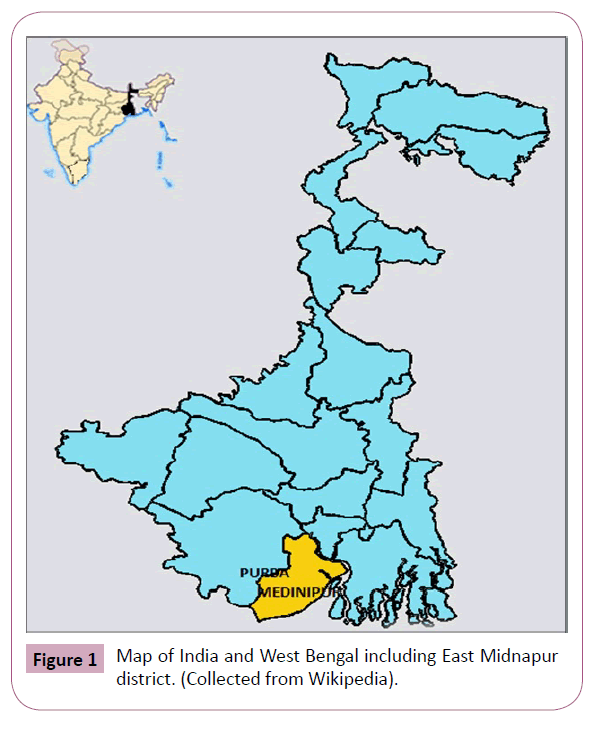
Figure 1: Map of India and West Bengal including East Midnapur district. (Collected from Wikipedia).
Result and Discussion
In East Midnapore District 37 invasive medicinal plants in 34 genera have been identified. Species diversity in Asteraceae family is more than any other family. In Asteraceae family 8 genera have been reported. Most of the invasive plants are native of Tropical America and Tropical Africa. All invasive medicinal plants has been tabulated in Table 1 and there medicinal values and uses have been described below. Exotic plants are invading and have been invaded in East Medinipur through food grain transport by lorry and cargo train, fertilizers, seeds, artificial forestation and plantation of ornamental plants (Ipomoea quamoclit Linn., Celosia argentea L.f., Mimosa pudica linn. and Lantana camara Linn.). Information about medicinal value of invasive medicinal plants has been taken from Medicinal Plant Resources of South West Bengal published by Research Wing, Directorate of Forest, Govt. of West Bengal.
| Sl. No. |
Scientific Name |
Family |
Native |
| 01 |
Acacia farnesianaWilld. |
Mimosaceae |
Trop. South America |
| 02 |
Ageratum conyzoides Linn. |
Asteraceae |
Trop. America |
| 03 |
Argemonemexicana Linn. |
Papaveraceae |
Trop. Cen.& S America. |
| 04 |
Blumealacera (Burm. f.) DC. |
Asteraceae |
Trop. America |
| 05 |
Calotropisgigantean (Linn.) R. Br. ex Ait. |
Asclepiadaceae |
Trop. Africa |
| 06 |
Cassia absus Linn. |
Caesalpiniaceae |
Trop. America |
| 07 |
Cassia alataLinn. |
Caesalpiniaceae |
West Indies |
| 08 |
Celosia argenteaL.f. |
Amaranthaceae |
Trop. Africa |
| 09 |
Crotalaria palliad Ait. |
Papilionaceae |
Trop. America |
| 10 |
Daturainnoxia Mill. |
Solanaceae |
Trop. America |
| 11 |
Daturametel Linn. |
Solanaceae |
Trop. America |
| 12 |
Ecliptaprostrata(L.) Linn. |
Asteraceae |
Trop. America |
| 13 |
Grangeamaderaspatana (L.) poir. |
Asteraceae |
Trop. South America |
| 14 |
HyptissuaveolensPoit. |
Lamiaceae |
Trop. America |
| 15 |
Ipomoea pes-tigridis Linn. |
Convolvulaceae |
Trop. East Africa |
| 16 |
Ipomoea quamoclit Linn. |
Convolvulaceae |
Trop. America |
| 17 |
Lantana camara Linn. |
Verbenaceae |
Trop. America. |
| 18 |
Leonotisnepetaefolia R. Br. |
Lamiaceae |
Trop. Africa |
| 19 |
Ludwigiaoctovalvis (Jacq.) Raven. |
Onagraceae |
Trop. Africa |
| 20 |
Martyniaannua Linn. |
Martyniaceae |
Trop. America |
| 21 |
Melilotus albaDesr. |
Papilionaceae |
Europe |
| 22 |
Mimosa pudica Linn. |
Mimosaceae |
Brazil |
| 23 |
Ocimumamericanum Linn. |
Lamiaceae |
Trop. America |
| 24 |
Opuntiastricta(Haw.) Haw. |
Cactaceae |
Trop. America |
| 25 |
Oxalis corniculatalinn. |
Oxalidaceae |
Europe |
| 26 |
Pedalium murex Linn. |
Pedaliaceae |
Trop. America |
| 27 |
Scopariadulcis Linn. |
Scrophulariaceae |
Trop. America |
| 28 |
SidaacutaBurm.f. |
Malvaceae |
Trop. America |
| 29 |
Solanumtorvum Sw. |
Solanaceae |
West Indies. |
| 30 |
Sonchusoleraceus Linn. |
Asteraceae |
Mediterranean |
| 31 |
Stachytarphetajamaicensis (Linn.) Vahl. |
Verbenaceae |
Trop. America |
| 32 |
SynedrellanodifloraGaertn. |
Asteraceae |
West Indies |
| 33 |
Tribulusterrestris Linn. |
Zygophyllaceae |
Trop. America |
| 34 |
Tridaxprocumbens Linn. |
Asteraceae |
Trop. Central America |
| 35 |
TriumfettarhomboideaJacq. |
Tiliaceae |
Trop. America |
| 36 |
Urenalobata Linn. |
Malvaceae |
Trop. Africa |
| 37 |
Xanthium strumarium Linn. |
Asteraceae |
Trop. America |
Table 1: Invasive medicinal plants and their medicinal values
Acacia farnesiana Wild
Family: Mimosaceae
Distribution: Medinipur and South West Bengal
Local Name: Babla
Used parts: bark, leaves, heartwood and flowers
Bark: used as astringent, decoction used to treat gleet, diarrhoea, decoction taken 4-5 times a day for a few days to treat dyspepsia, soaked in water and taken for 2-3 days to treat the leucorrhoea and menorrhagia.
Leaves: used to treat gonorrhoea.
Heartwood: 7-10 gms heartwood boiled in ½ lit of water taken 2-3 times in a day to treat diabetes.
Flowers: fresh flower juice with water and milk taken for 2-3 days to treat haemoptysis (Figure 2).
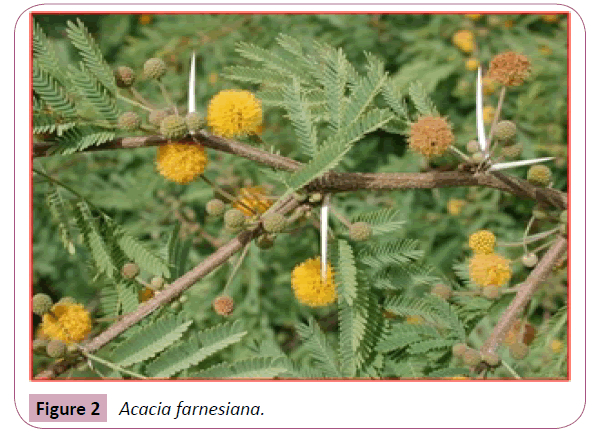
Figure 2:Acacia farnesiana.
Ageratum conyzoides Linn
Family: Asteraceae
Distribution: Medinipur and South West Bengal
Used parts: leaves, root and whole plant body
Leaves: applied on wounds, boils, skin disease and leprosy.
Root: used as antidysentric, anhelmintic, used in purulent ophthalmia.
Whole plant body: used to treat ague, prolapsus, renal and vesical calculi; decoction or infusion used in diarrhoea, dysentery (Figure 3).
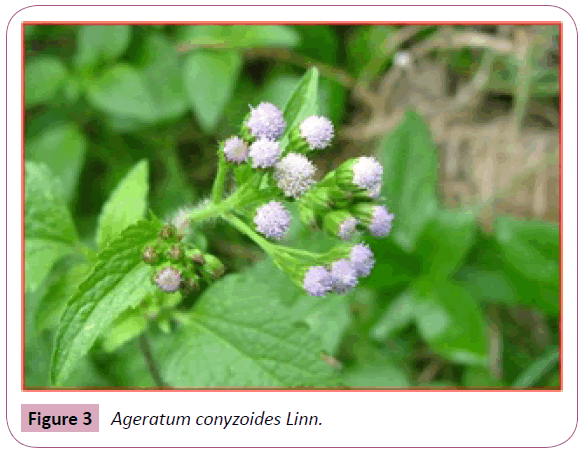
Figure 3: Ageratum conyzoides Linn.
Argemone maxicana Linn
Family: Papaveraceae
Distribution: Medinipur and South West Bengal.
Used parts: seeds, root, yellow gum and whole plant body
Seeds: used as cathartic, used in contentious troubles, scabis, opthalmia, boils, leprosy, psoriasis, rat bite: decoction taken to cure palpitation; seed pest with mahua oil used to cure eczyma.
Roots: used as stimulant used in skin disease, blennorrhagia
Yellow gum: used to treat disease of urinary tract, jaundice, gonorrhoea and leprosy.
Whole plant: juice used to treat eye disease; with common salt the juice is used to cure scabies, ringworm; juice with onion pest applied to kill the parasitic insect on the body of domestic animals, juice with turmeric pest used to cure skin disease. (Picture captured by author) (Figure 4).
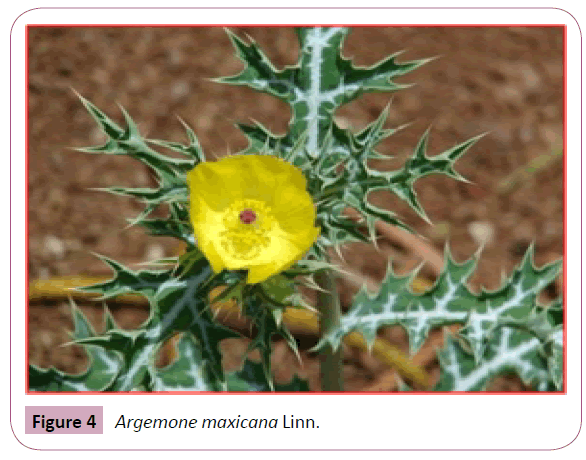
Figure 4: Argemone maxicana Linn.
Blumea lacera (Burm. F.) DC.
Family: Asteraceae
Distribution: Medinipur and South West Bengal
Local Name: Vukuksima
Used parts: whole plant, roots and leaves
Whole plant: used to cure bronchitis, fever, blood disease, thirst and bleeding piles.
Root: used in cholera and mouth disease, root pest with Dalim (Punica granatum) and Begun (Solanum melongena) in equal quantities used to women to treat of check breeding after childbirth.
Leaves: fresh leaves juice applied on the affected parts to prevent chicken pox (Picture captured by author) (Figure 5).
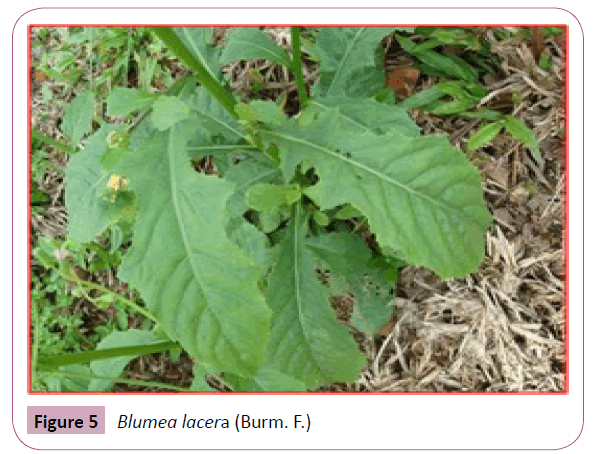
Figure 5: Blumea lacera (Burm. F.)
Calotropis gigantean (Linn.) R. Br. ex Ait.
Family: Asclepiadaceae
Distribution: Medinipur and South West Bengal
Local Name: Sada akanda
Used parts: root bark, root, leaves, latex and flowers
Root bark: used in dysentery, elephantiasis
Root: decoction with long pepper pest given to cure leucorrhoea, fresh decoction used to cure the fever after delivery, powder of root bark with mustard oil used to cure earache.
Leaves: juice of fresh leaves used to treat intermittent fever, earache and elephantiasis.
Latex: latex used to treat the wound caused by poisonous insect and catfish bites, to cure pain in the gum of the teeth, ringworm, to cure the septic wounds of cattle.
Flowers: flower powder with black pepper used to cure asthma, also useful to cold, cough and indigestion (Figure 6).
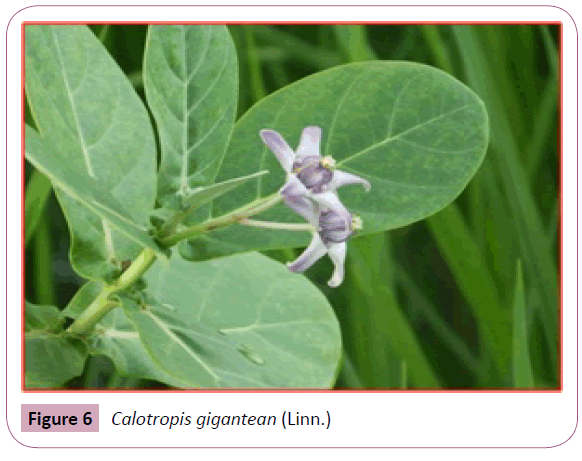
Figure 6: Calotropis gigantean (Linn.)
Cassia absus Linn.
Family: Caesalpiniaceae
Distribution: Medinipur, Bankura, Purulia
Used parts: leaves, root and seeds
Leaves: leaves juice used to enrich the blood, used to treat the disease of nose, cough and cold
Roots: used in the constipation
Seeds: pest of seeds is used to treat leucoderma, ringworm and constipation (Figure 7).
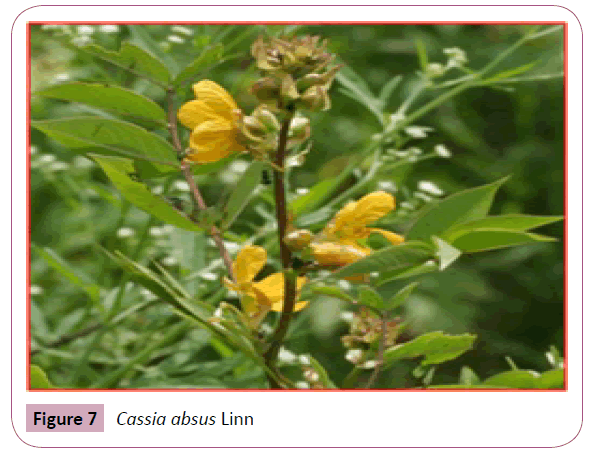
Figure 7: Cassia absus Linn
Cassia alata Linn.
Family: Caesalpiniaceae
Distribution: Medinipur and South Bengal.
Used parts: leaves.
Leaves: paste applied to treat ringworm, cough, asthma and leprosy (Figure 8).
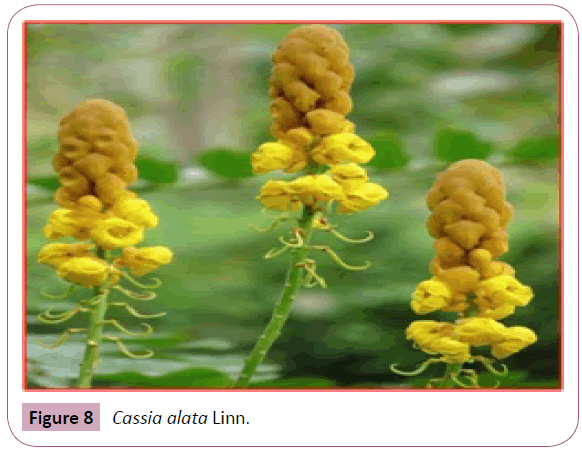
Figure 8: Cassia alata Linn.
Celosia argentea L.f.
Family: Amaranthaceae
Distribution: Medinipur and south West Bengal. Local Name: Morog jhuti.
Used parts: seeds and root
Seeds: extract of seeds used to treat eye disease and clearing the vision. Paste of seed is used as diuretic, aphrodisiac and used to treat mouth sores.
Roots: fresh roots chewed in empty stomach twice daily as a painkiller (Figure 9).
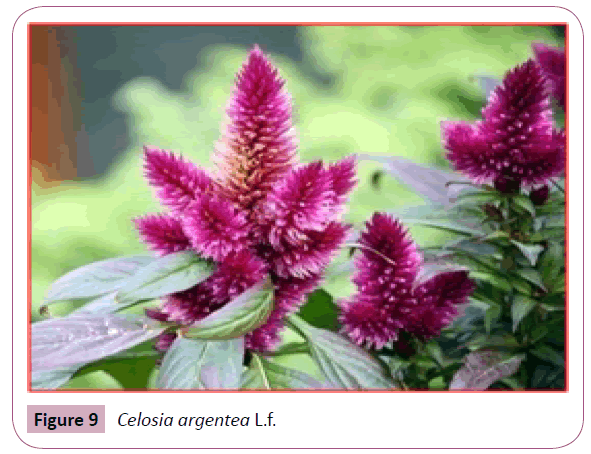
Figure 9: Celosia argentea L.f.
Crotalaria pallid Ait.
Family: Papilionaceae
Distribution: Medinipur and south west Bengal.
Used parts: whole plant and seeds
Whole plant: extract of plant used as hypotensive and antitumour.
Seeds: powder of seeds used as substitute of coffee (Figure 10).
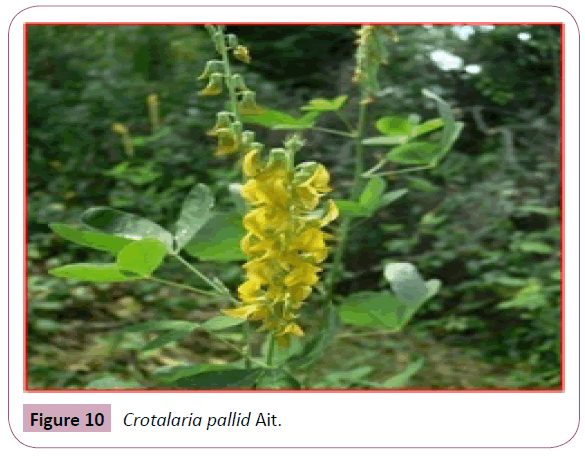
Figure 10: Crotalaria pallid Ait.
Datura innoxia Mill.
Family: Solanaceae
Distribution: Medinipur and south West Bengal.
Local Name: Dhutra. (Picture captured by author)
Used parts: whole plants, roots and leaves.
Whole plants: used in asthma, chronic cough, rheumatic swelling, epilepsy, earache, gout inflamed breast etc.
Roots: used to treat madness; paste of roots of D. innoxia and punarnova (Boerhavia diffusa) with milk or cold water used to treat in dog bite.
Leaves: juice applied on the head to treat alopecia; juice used to cure swelling and pain, breast pain, and dysentery, dry leaves with Basak(Adhatoda vasica) leaves smoked to treat the asthma; leaves, petioles and fruit boiled in mustard oil and applied by women to treat mastitis (Thunka) (Figure 11).
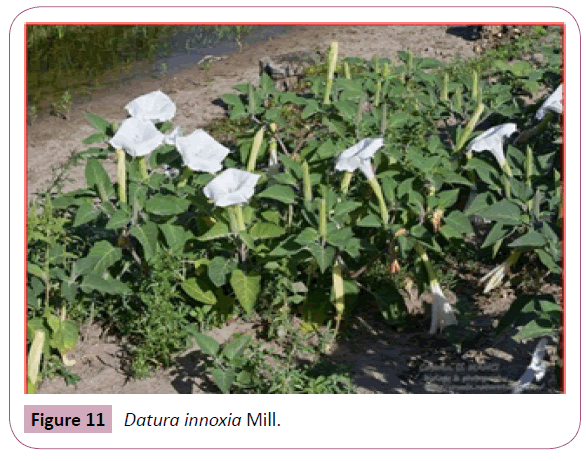
Figure 11: Datura innoxia Mill.
Datura metel Linn.
Family: Solanaceae
Distribution: throughout West Bengal.
Local name: Krishna Dhutra.
Used parts: whole plant, roots, leaves, seeds and fruits
Whole plant: paste of whole plant used to treat asthma, cough, fever, skin disease; juice with fresh cow milk used to cure gonorrhoea.
Roots: paste with karanja(Millettia pinnata) oil applied to treat leucoderma, used to treat rabid dog bite.
Leaves: leaves’ juice used to treat various inflammatory swelling, epilepsy, dandruff, rheumatic pain; leaves’ juice with Rerhi (Ricinus communis) oil and clarified butter boiled together and as liniment once at bedtime to treat rheumatic pain.
Seeds: used in odontalgia, otalgia, gastropathy, skin disease, dandruff, lice, hydrophobia, leucoderma; fresh leaves’ juice with Karanja oil (Millettia pinnata) used to treat leucoderma.
Fruit: fresh juice with mustard oil (Brassica campestris) applied to prevent falling of hair (Figure 12).
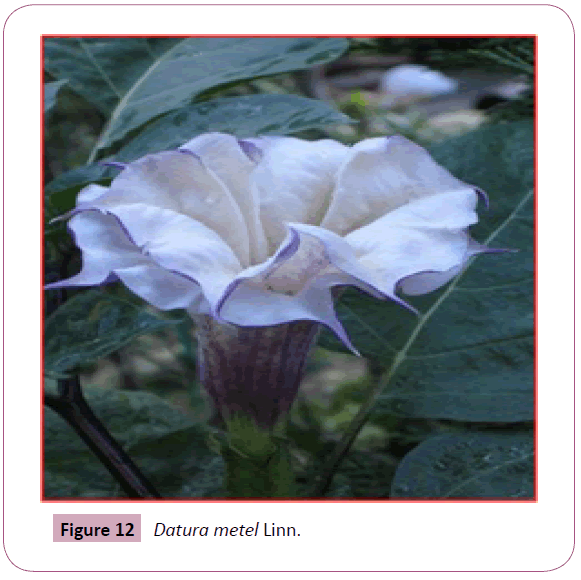
Figure 12: Datura metel Linn.
Eclipta prostrata (L.) Mant.
Family: Asteraceae
Distribution: throughout West Bengal. Local name: Kesuth.
Used parts: leaves, whole plants and roots
Leaves: used in jaundice, fever, to promote hair growth
Whole plant: used to treat elephantiasis, skin disease, asthma, bronchitis, fresh juice used to treat scorpion stings, paste applied to treat swelling of glands of cattle; juice with coconut oil used as drop to treat eye troubles.
Root: useful in case of scalding of urine (Figure 13).
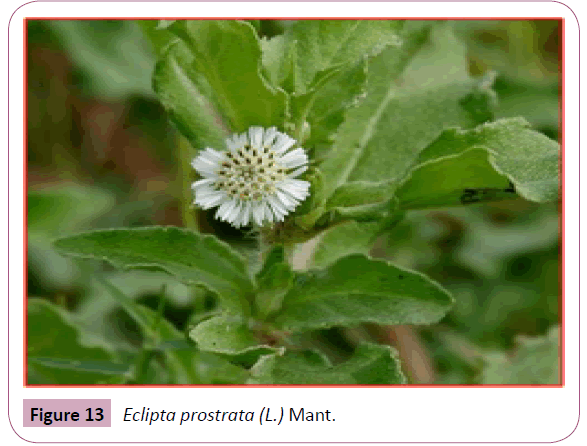
Figure 13: Eclipta prostrata (L.) Mant..
Grangea maderaspatana (L.) poir.
Family: Asteraceae
Distribution: Medinipur and south West Bengal.
Used parts: leaves
Leaves: juice of leaves used as instillation for earache, infusion of leaves considered stomachic, antispasmodic (Figure 14).
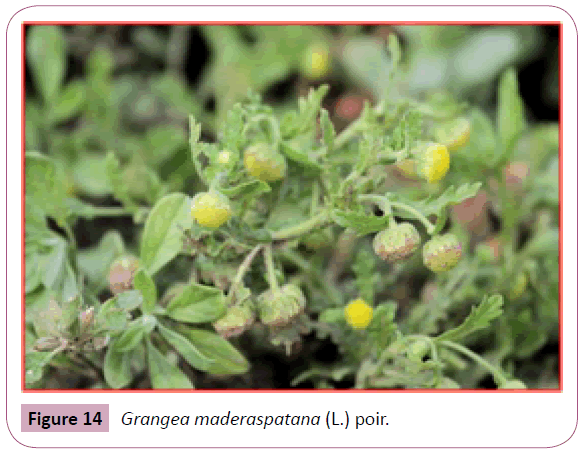
Figure 14: Grangea maderaspatana (L.) poir.
Hyptis suaveolens Poit
Family: Lamiaceae
Distribution: Midnapore and throughout south Bengal.
Local Name: Ban tulsi.
Used parts: whole plant, roots, flowering shoots and leaves.
Whole plant: used as carminative, sudorific, lactagogue, and stimulant; infusion used uterus affections, and parasitical cutaneous diseases (Figure 15).
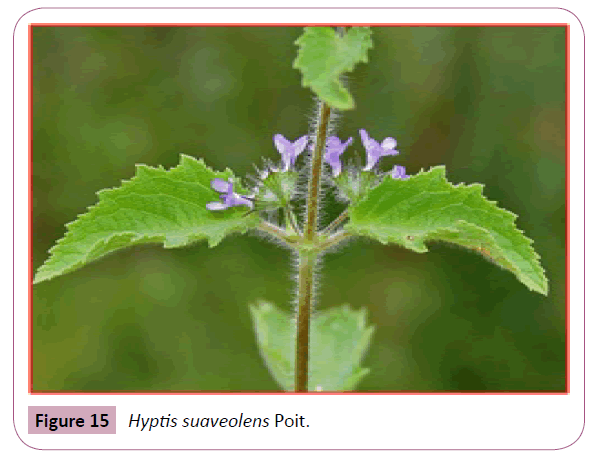
Figure 15: Hyptis suaveolens Poit.
Roots: decoction used as appetizer, root chewed with betel nut as a stomachic.
Flowering shoots: used as ant-rheumatic, ant-soporific, antispasmodic, applied to paralysis.
Leaves: juice used in colic
Ipomoea pes-tigridis Linn.
Family: Convolvulaceae
Distribution: South West Bengal, Medinipur.
Used parts: roots
Roots: used as purgative, antidoteto dog bite; used in boil, carbuncle and colic (Figure 16).
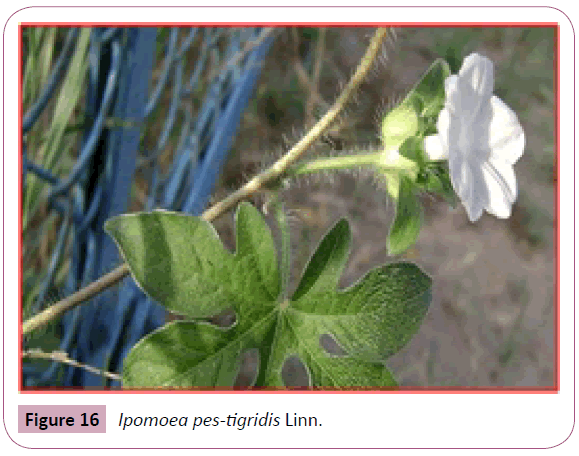
Figure 16: Ipomoea pes-tigridis Linn.
Ipomoea quamoclit Linn.
Family: Convolvulaceae
Distribution: Medinipur, south West Bengal.
Used parts: leaves
Leaves: paste applied to bleeding piles and carbuncle; useful in headache (Figure 17).
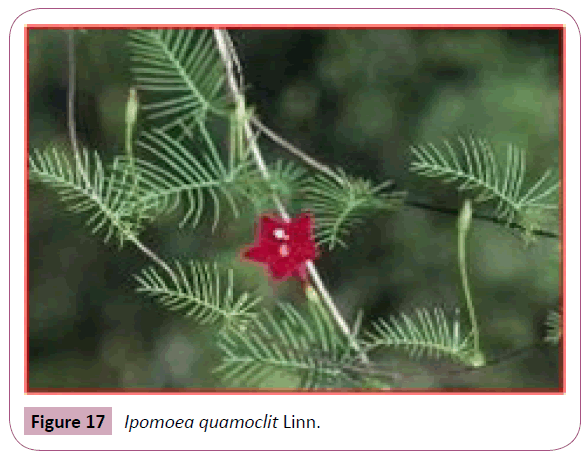
Figure 17: Ipomoea quamoclit Linn.
Lantana camara Linn.
Family: Verbenaceae
Distribution: Medinipur, Bankura, Purulia and south West Bengal.
Local Name: Chotra.
Used parts: whole plants
Whole plants: used as antiseptic, antispasmodic, carminative, laxative, antidote to snake venom; useful in tetanus, epilepsy, malaria, gastropathy, cuts and wounds, ulcer, swelling, fistula (Figure 18).
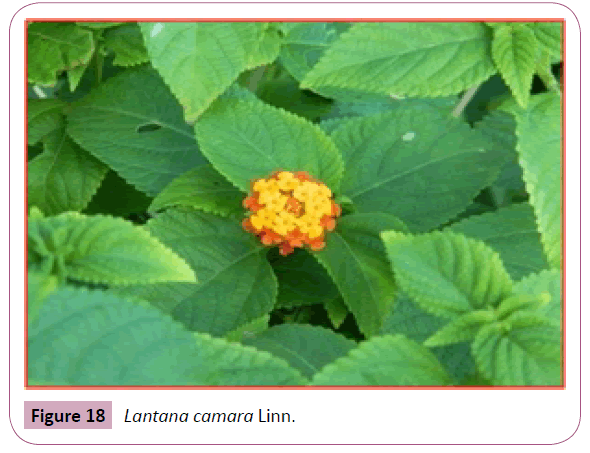
Figure 18: Lantana camara Linn.
Leonotis nepetaefolia R. Br.
Family: Lamiaceae
Distribution: Medinipur, Bankura, Purulia and south West Bengal.
Used parts: flower, roots and leaves.
Flower: paste with curd applied to treat ringworm and itchy skin also paste is used to treat burning. Paste with koranja (Millettia pinnata) oil used to treat sore of children.
Roots: crushed and rubbed on the breast when it swells and milk does not pass through the nipples.
Leaves: decoction of leaves used as tonic (Figure 19).
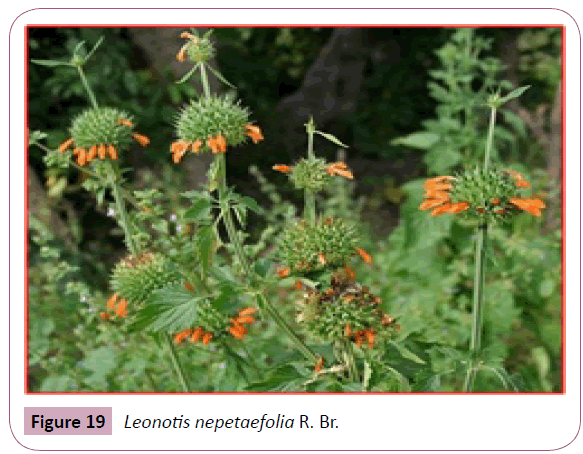
Figure 19: Leonotis nepetaefolia R. Br.
Ludwigia octovalvis (Jacq.) Raven.
Family: Onagraceae
Distribution: throughout West Bengal.
Used parts: whole plants
Whole plants: paste with buttermilk considered useful in dysentery; decoction used as vermifuse, purgative; boiled root juice used in fever; juice in empty stomach is antihelmintic and full stomach is good for digestion (Figure 20).
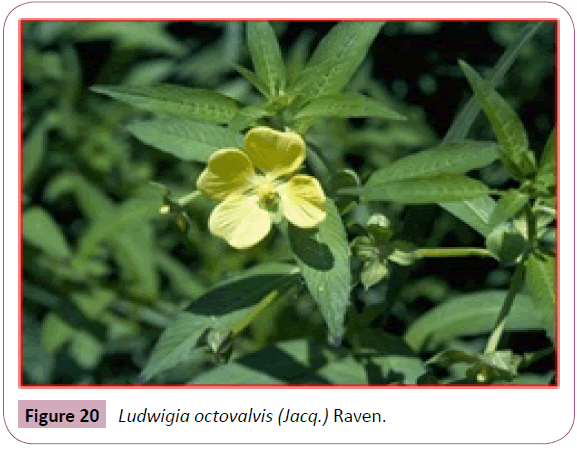
Figure 20: Ludwigia octovalvis (Jacq.) Raven.
Martynia annua Linn.
Family: Martyniaceae
Distribution: Digha in Purba Medinipur and South West Bengal.
Local name: Bagh nakh.
Used parts: leaves and fruits.
Leaves and fruits: used to inflammation, to treat epilepsy, tuberculosus glands of neck; juice used as gargle for sore throat (Photo from Wikipedia) (Figure 21).
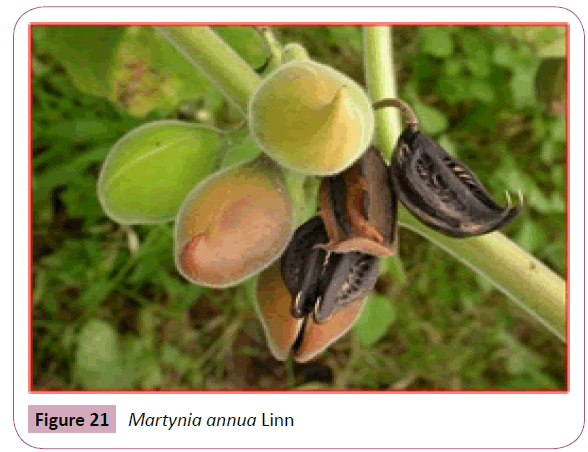
Figure 21: Martynia annua Linn.
Melilotus alba Desr.
Family: Papilionaceae.
Distribution: all over west Bengal
Used parts: whole plant
Whole plants: used as emollient; carminative, styptic; used to bruises (Photo from Wikipedia) (Figure 22).
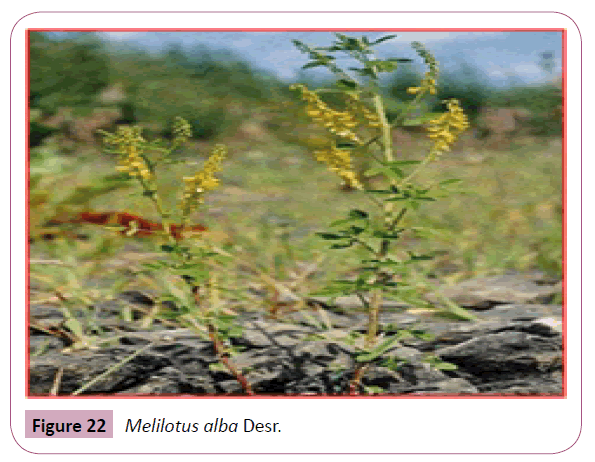
Figure 22: Melilotus alba Desr.
Mimosa pudica linn.
Family: Minosaceae
Distribution: all over West Bengal. Local Name: Lajjabati
Used parts: whole plants, roots, leaves
Whole plants: paste applied to treat swelling of cattle, decoction with milk taken to treat bleeding piles; stem bark with karanja (Millettia pinnata) oil used to cure leucoderma
Roots: used to treat leprosy, dysentery, vaginal and uterine complaints, inflammation, asthma, leucoderma, piles; paste with black pepper used to treat orchitis
Leaves: juice applied on cut to stop bleeding; leaves decoction with ginger taken as depurative (Figure 23).
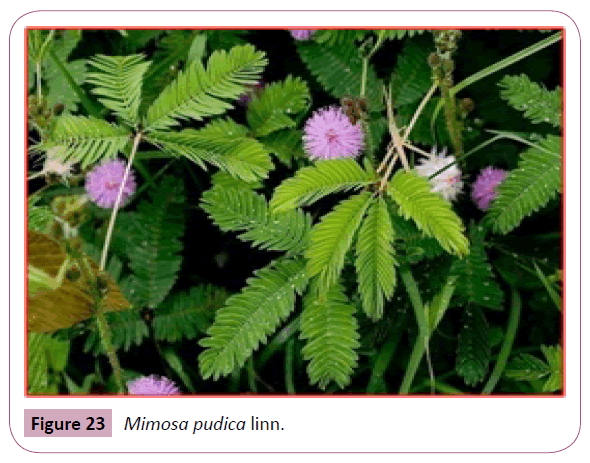
Figure 23: Mimosa pudica linn.
Ocimum americanum Linn.
Family: Lamiaceae
Distribution: all over West Bengal. Local Name: Babui tulsi
Used parts: roots, leaves and seeds
Roots: used to treat bowel complaints of children
Leaves: used to treat ringworm and scorpion sting
Seeds: useful in gonorrhoea, diarrhoea, chronic dysentery (Figure 24).
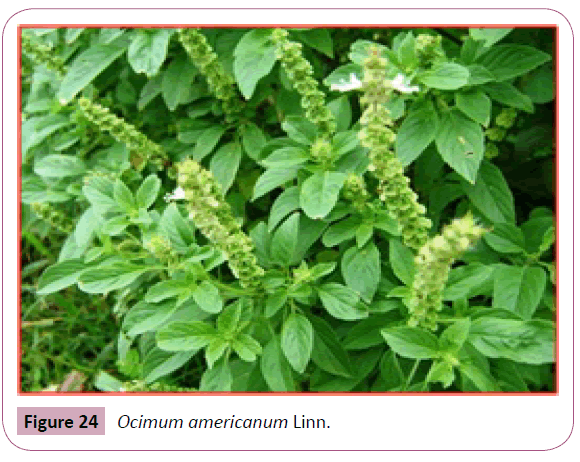
Figure 24: Ocimum americanum Linn.
Opuntia stricta (Haw.) Haw.
Family: Cactaceae
Distribution: coastal area and drought area of West Bengal
Local Name: Fani manasa
Used parts: whole plant, fruit, milky juice and flower
Whole plants: used as contraceptive, used to treat cough, gonorrhoea, urinary complaints, leucoderma and enlarged spleen
Fruits: baked fruit used to treat whooping cough
Milky juice: used as purgative
Flower: useful in bronchitis and asthma (Figure 25).
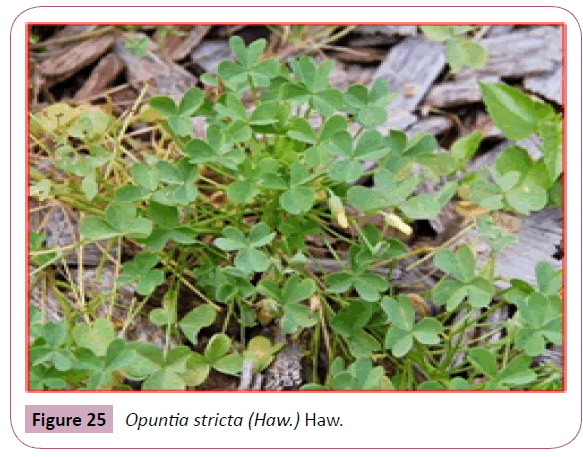
Figure 25: Opuntia stricta (Haw.) Haw.
Oxalis corniculata linn.
Family: Oxalidaceae
Distribution: all over west Bengal
Local name: Amrul
Use parts: leaves and whole plant
Leaves: used to remove warts and opacities of cornea; used to treat boils, scurvy, fever, dysentery, piles and diarrhoea
Whole plants: fresh juice given in piles, anaemia and tympani ties; juice mixed with oil and applied as massage to remove cough; juice taken to treat low back pain, urinary troubles and applied to treat itch (Figure 26).
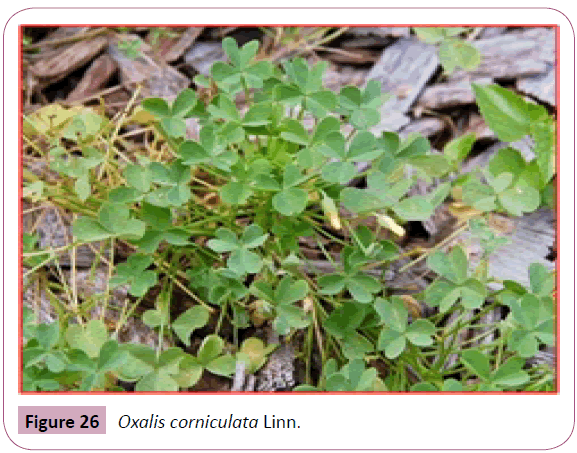
Figure 26: Oxalis corniculata Linn.
Pedalium murex Linn.
Family: Pedaliaceae
Distribution: Medinipur and dry sandy waste place of south West Bengal
Used parts: roots and fruits, leaves, fruits, leaves and stem, seeds
Roots and fruits: used to treat strangury, urinary discgarges, vesicular calculi, inflammation, cough, asthma, pain, piles etc (Figure 27).
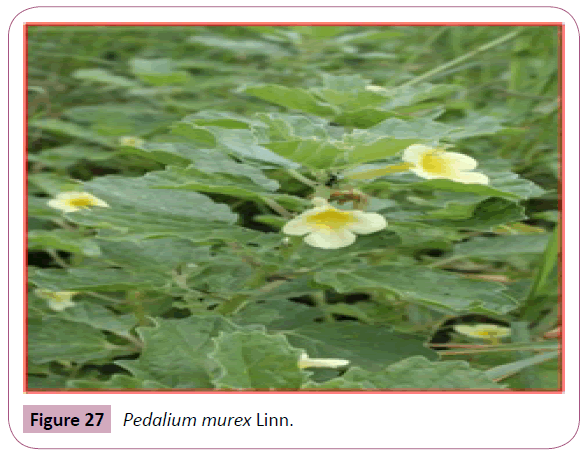
Figure 27: Pedalium murex Linn.
Leaves: used to increase menstrual flow and to purify blood
Fruits: used to cure calculus affection, urinary disorders, kidney disease; used to promote the lochial discharges
Fresh leaves and stems: used in gonorrhoea and dysuria
Seeds: used in case of urinary troubles, stone in bladder
Scoparia dulsis Linn.
Family: Scrophulariaceae
Distribution: all over West Bengal
Local name: Ban dhane
Used parts: leaves, whole plant, roots and seeds
Leaves: used to treat cough, stomach troubles; leaves juice used in empty stomach to cure painful urination, to treat diabetes
Whole plant: used to treat stone in bladder and kidney; paste used to cure toothache, mouth ulcer and used to treat diabetes
Roots: used in diarrhoea and dysentery; paste of root used to cure excessive menstruation
Seeds: powder with sugar given to treat kidney stone (Figure 28).
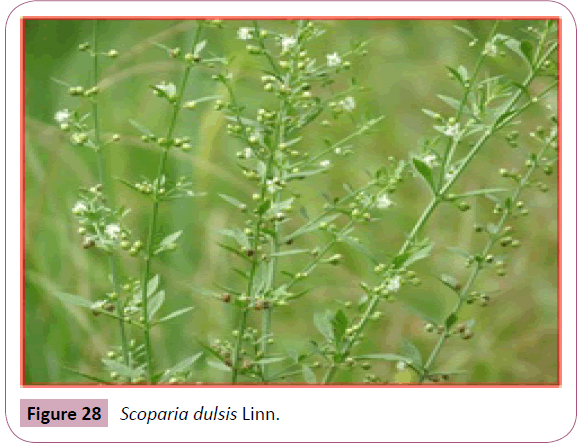
Figure 28: Scoparia dulsis Linn.
Sida acuta Burm.f.
Family: Malvaceae
Distribution: all over West Bengal
Used part: roots, leaves
Roots: used as anti pyretic, diaphoretic, stomachic, used to increase appetite and to promote perspiration.
Leaves: used as diuretic, boiled with oil applied to testicular swelling and elephantiasis (Figure 29).
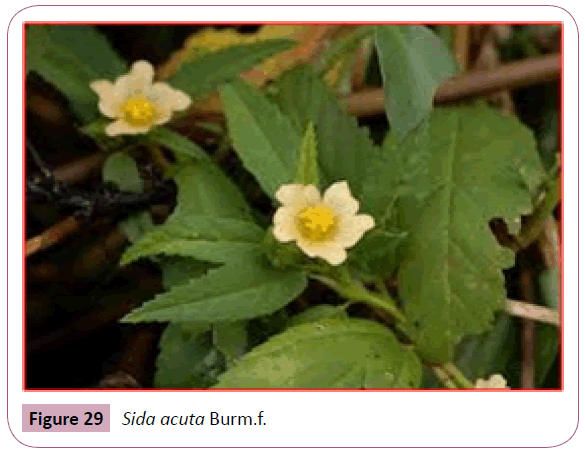
Figure 29: Sida acuta Burm.f.
Solanum torvum Sw.
Family: Solanaceae
Distribution: most part of West Bengal
Used Parts: Whole plant, fruits and roots
Whole plant: used as sedative, diuretic and stomachic (Figure 30).
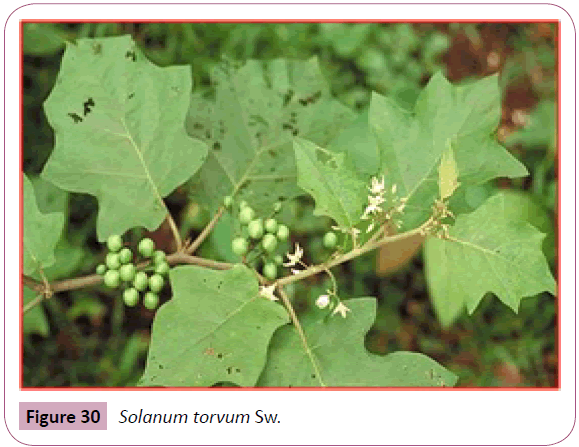
Figure 30: Solanum torvum Sw.
Fruits: decoction used to cure cough; useful in liver and spleen enlargement
Roots: pounded roots applied in cracks in the feet
Sonchus oleraceus Linn.
Family: Asteraceae
Distribution: throughout hotter part of West Bengal
Used parts: whole plant, roots and leaves, stem and gum
Whole plant: used to treat liver troubles and used as glactagogue
Roots and leaves: paste of root and leaves used to treat in indigestion.
Stem: used as tonic and sedative.
Gum: gum is used as powerful hydragogue (Figure 31).
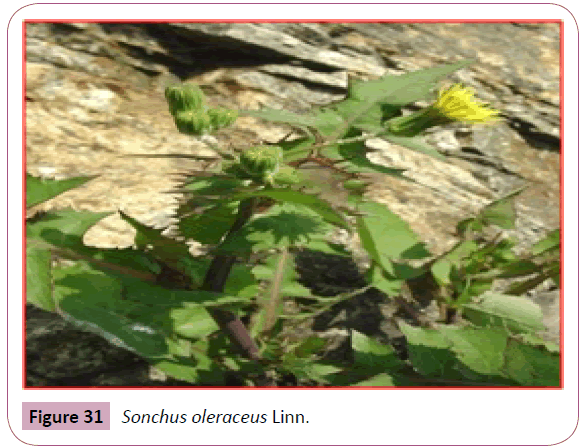
Figure 31: Sonchus oleraceus Linn.
Stachytarpheta jamaicensis (Linn.) Vahl.
Family: Verbenaceae
Distribution: cultivated in garden and also found by the road sides
Used parts: whole plant, bark and leaves
Whole plant: used to remove the intestinal worms; used to treat ulcer, dropsy etc.
Bark: infusion of bark useful in diarrhoea and dysentery
Leaves: used for cardiac troubles; decoction used to treat ulceration of nose (Figure 32).
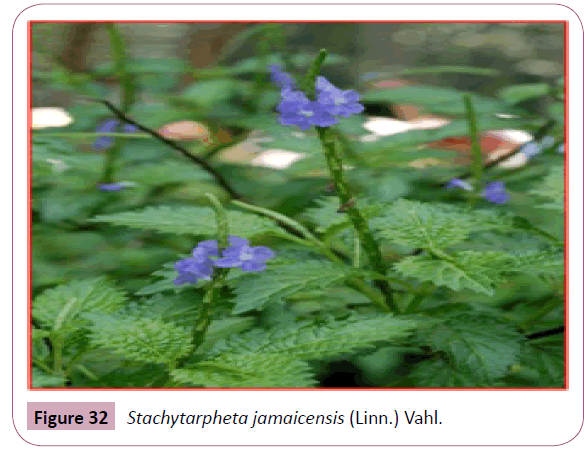
Figure 32: Stachytarpheta jamaicensis (Linn.) Vahl.
Synedrella nodiflora Gaertn.
Family: Asteraceae
Distribution: throughout the West Bengal
Used parts: leaves
Leaves: boiled leaves used as laxative; leaves’ paste used to treat rheumatism (Figure 33).
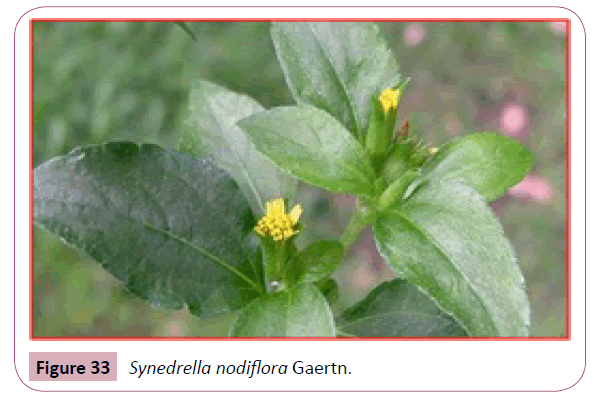
Figure 33: Synedrella nodiflora Gaertn.
Tribulus terrestris Linn.
Family: Zygophyllaceae
Distribution: drought parts of West Bengal (Photo from Wikipedia).
Used parts: roots and fruits, leaves, seeds, fruits
Roots and fruits: used for urine discharge; used in inflammation, cough, asthma, pain, piles, leprosy and gleet.
Leaves: used as stomachic, increase the menstrual flow
Seeds: used to treat urinary troubles, stone in the bladders
Fruit: used as diuretic, tonic, used to treat painful micturition (Figure 34).
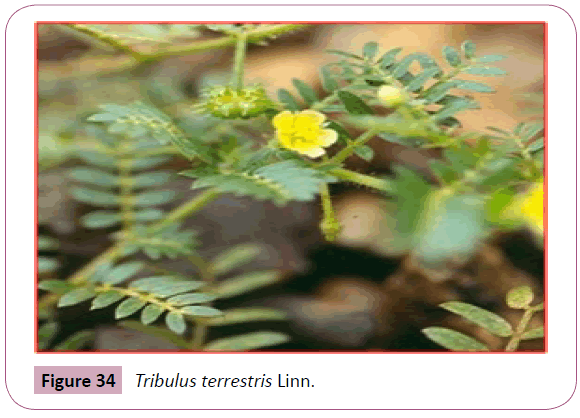
Figure 34: Tribulus terrestris Linn.
Tridex procumbens Linn.
Family: Asteraceae
Distribution: most part of West Bengal
Used parts: whole plant and leaves
Whole plant: used in bronchial catarrh, dysentery, diarrhoea
Leaves: used as antidiarrhoeal, antidysenteric; juice used as septic in bleeding wounds (Figure 35).
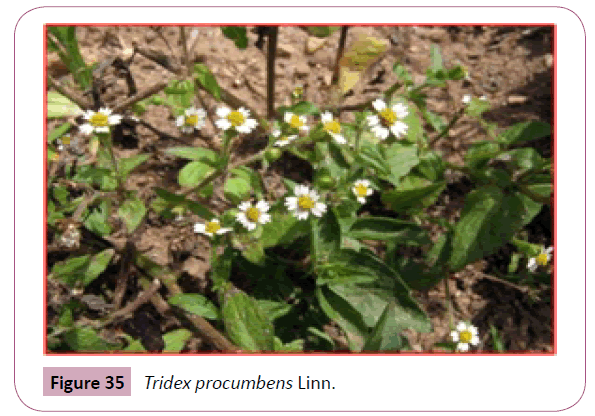
Figure 35: Tridex procumbens Linn.
Triumfetta rhomboidea Jacq.
Family: Tiliaceae
Distribution: road side of West Bengal
Used parts: root, bark and leaves, leaves
Root: used as diuretic, used in dysentery, inflamed eyes, paste given to treat intestinal worms and applied to treat pimples
Bark and leaves: used in diarrhoea
Leaves: fresh juice used to treat diarrhoea, used to cure inflammation and swelling (Figure 36).
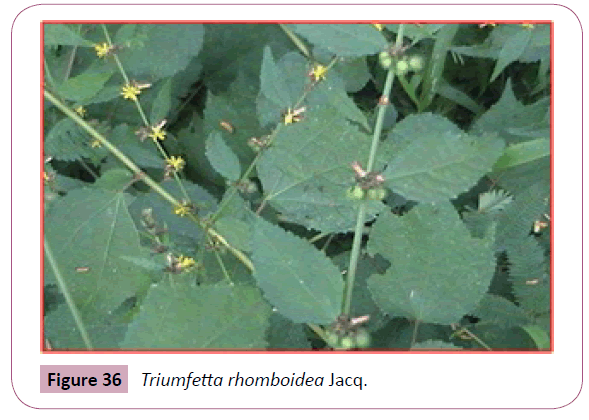
Figure 36: Triumfetta rhomboidea Jacq.
Urena lobata Linn.
Family: Malvaceae
Distribution: most part of West Bengal (Photo from Wikipedia).
Used parts: root, flowers, leaves and stem
Roots: used to treat rheumatism, used as diuretic
Flowers: used as expectorant; used in apthae and sore throat
Leaves: fresh juice applied to treat bone fracture; paste applied to septic wounds
Stem: used to treat stomach troubles of children in rainy season (Figure 37).
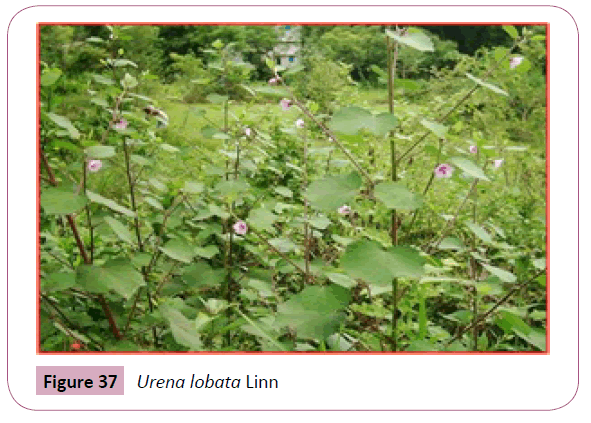
Figure 37: Urena lobata Linn
Xanthium starmarium Linn.
Family: Asteraceae
Distribution: waste land in all over West Bengal.
Local Name: Jatafal
Used parts: roots, whole plant, leaves, fruit, seeds
Roots: used in glandular swelling, herpes, ulcer and hyperglycemia
Whole plant: used as diaphoretic, plant decoction used in chronic malaria, leucorrhoea, urinary disease.
Leaves: used as diuretic and anti-syphilitic; used to treat malaria fever
Fruits: rich in vitamin-C, used in pox and inflammation
Seeds: used for resolving inflammatory swelling, seed oil useful in bladder affection and herpes (Figure 38).
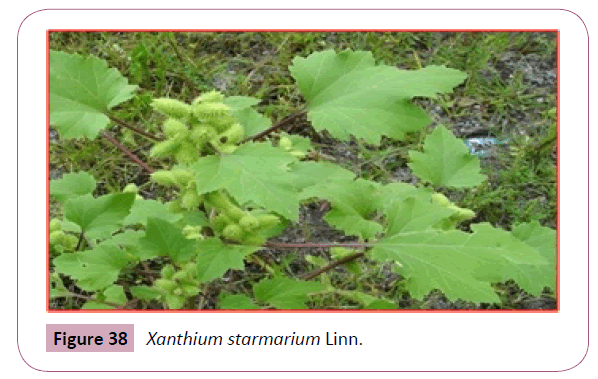
Figure 38: Xanthium starmarium Linn.
Conclusion
This paper is my little effort to open the basic science. Through this research I have tried to light on invasive and medicinal plants of East Midnapore district. This is the first time any body has tried on this topic. In future many scientists will be interested on this topic. Many invasive plants are used by local people as medicine. Many of them are not known to local people. But these plants have the medicinal value. Invasive species are harmful to endemic vegetation. So, invasive plant species have dual effect. In this topic extensive research is needed.
Acknowledgement
I am thankful to my family for continuous moral supports. I also bid thanks to my all friends who have supported and helped me. I am grateful to my departmental teachers and students.
8687
References
- Almeilla ID, Freitas H (2001) The exotic and invasive flora of Portugal. Bot Complutensis 25: 317-327.
- Armstrong S (1995) Rare plants protect Cape’s water supplies. New Scientist. February 11.pp.8.
- Chapin FS III, Zavaleta ES, Eviner VT, Naylor RL, Vitousek PM, et al. (2000) Consequences of changing biodiversity. Nature, 405: 234-242.
- Chen B, Kang L (2003) Biological invasion and its relation with global changes. Chin J Ecol22(1): 31-34.
- CMFRI-DBT (2009) DBT project report on “Development of genetically improved strains of Brine shrimp, Artemia using quantitative and molecular genetic tools”. CMFRI, Cochin.
- Convention on Biological Diversity (CBD) (2001) Alien species that threaten ecosystems, habitats or species. Annex: interim guiding principles for the prevention introduction and mitigation of impacts of alien species. Available at: http;//www.biodiv.org.
- Corlett RT (1988) The naturalized flora of Singapore. Journal of Biogeography 15: 657-63.
- Cowie R (2000) Does the public care about species loss? A glimpse into the public’s thinking. Conservation Biology in Practice 2(3): 28-9.
- Cox GW (2004) Alien Species and Evolution: The Evolutionary Ecology of Exotic Plants, Animals, Microbes, and Interacting Native Species. Island Press, Washington, D.C.
- Cox GW (1999) Alien Species in North America and Hawaii: Impacts on Natural Ecosystems. Island Press, Washington, D.C.
- Cracraft J, Francesca T (1999) The Living Planet in Crisis. Columbia University Press, New York.












































